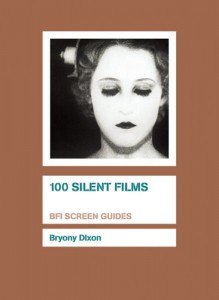100 Silent Films by Bryony Dixon (BFI, 2011). 227 pages. ISBN: 978-1844573080 (paperback). £16.99
 About the reviewer: Michael Hammond took his BA in History at California State University Los Angeles, his MA in Film Studies at the University of East Anglia, and PhD at Southampton Institute. He is currently a Senior Lecturer at the University of Southampton. His publications include: with Michael Williams (eds.) British Silent Cinema and the Great War (2011, Palgrave Macmillan); with Linda Ruth Williams (eds.) Contemporary American Cinema (2006, Open University Pres); The Big Show: British cinema culture in the Great War (1914-1918) (2006, University of Exeter Press)
About the reviewer: Michael Hammond took his BA in History at California State University Los Angeles, his MA in Film Studies at the University of East Anglia, and PhD at Southampton Institute. He is currently a Senior Lecturer at the University of Southampton. His publications include: with Michael Williams (eds.) British Silent Cinema and the Great War (2011, Palgrave Macmillan); with Linda Ruth Williams (eds.) Contemporary American Cinema (2006, Open University Pres); The Big Show: British cinema culture in the Great War (1914-1918) (2006, University of Exeter Press)
So Far Yet So Near: The Lively World of Silent Cinema
In her informed and delightfully written BFI Guide to 100 Silent Films, Bryony Dixon quotes Gloria Swanson as Norma Desmond in Sunset Blvd (Billy Wilder, 1950), 'We didn’t need dialogue. We had faces.' Looked at now it is remarkable how this was only slightly over 20 years after the coming of sound. It was as if a whole art form which had burned bright and furious for three and half decades bowed to the old show biz requirement of sustaining the illusion.
 Now sixty years later silent cinema is surviving, not only on University courses, where it has been a staple in some form or another since the 1960s, but at art cinemas, in National Theatre retrospectives and at the explosion of summer music and art festivals in Britain. True it has never really gone away, thanks to the tireless efforts over the years of the likes of Kevin Brownlow, David Robinson, the Pordenone Film Festival as well as the emergence of the study of early and silent cinema spearheaded by scholars in Universities across the world. But it is experiencing a re-emergence into the public purview that it has not been enjoyed since the 60s and 70s of the Thames Silents and the restoration of Abel Gance’s Napoleon (1927).
Now sixty years later silent cinema is surviving, not only on University courses, where it has been a staple in some form or another since the 1960s, but at art cinemas, in National Theatre retrospectives and at the explosion of summer music and art festivals in Britain. True it has never really gone away, thanks to the tireless efforts over the years of the likes of Kevin Brownlow, David Robinson, the Pordenone Film Festival as well as the emergence of the study of early and silent cinema spearheaded by scholars in Universities across the world. But it is experiencing a re-emergence into the public purview that it has not been enjoyed since the 60s and 70s of the Thames Silents and the restoration of Abel Gance’s Napoleon (1927).
This new dawn is in large part due to the work of archivists and the reappearance of newly restored versions available commercially on DVD. So it is pertinent that the BFI devote attention to silent cinema and offer an accessible guide to some of its many treasures. Dixon, curator of the silent film holdings at BFI National Archive confidently guides us through 100 silent films, offering an eclectic range of genres from the earliest shorts, through actualities, animations, avant-garde and features. She points out in her introduction that Silent Cinema is not a genre as the other Guides in this series primarily are. In fact, as Dixon implies, it is almost wholly another art form. Serious scholars and enthusiasts know this and it is Dixon’s understanding of the dual function of this guide, to introduce as well as to inform, that will make it a useful reference for students as well as a general guide for the uninitiated.
There is much here that will be familiar but Dixon offers concise perspectives on how these have been enhanced by recent scholarship and archive work. There is the important recognition of the paradox of The Birth of a Nation (D.W. Griffith, US, 1915), at once reprehensible and influential, but also that its impact owed a great deal to its expansive presentation in theatres. She reassesses The Battleship Potemkin (Sergei Eisenstein, USSR 1925) with its missing footage replaced. But there is also much more, such as the inclusion of the beautiful Daybreak (Tianming) (Sun Yu, China, 1933). This is a fine example of the remarkable output of the Shanghai studios which lasted until the Japanese invasion in 1937. There is the cross-cutting and split screen innovations of Lois Weber’s Suspense (US 1913) and the inclusion of Winsor McKay, not Gertie the Dinosaur (US 1914) but an earlier film, How a Mosquito Operates (US, 1912).
Dixon clearly knows her material and she explains it in an accessible style. She offers both poetic and pithy descriptions of narratives while she weaves her way through the ‘classics’, the popular and the obscure, tempting the reader to watch them all. At times she takes us by the scruff of the neck such as when she makes no apologies for a ‘slightly British bias’. This is a strength that allows the inclusion of Asquith’s A Cottage on Dartmoor (1929) and The Battle of the Somme (William F. Jury, 1916), both of which benefit from the context Dixon provides. This book will be a welcome support for film students. Perhaps more importantly for the casual reader it returns the world of silent cinema to the limelight.
Dr Michael Hammond